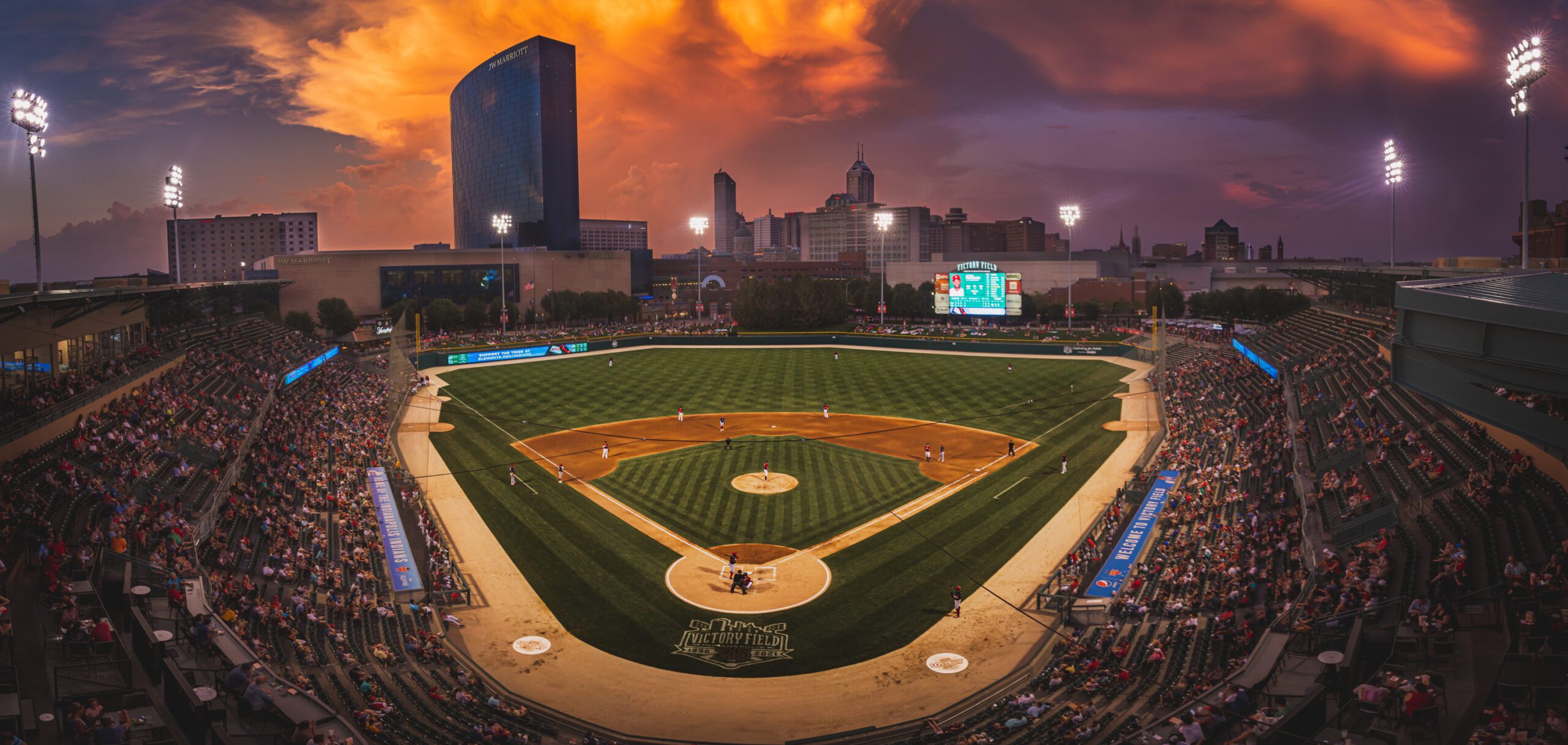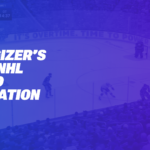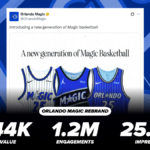
13 May MiLB Social Value: Comparing MLB and MiLB’s Impact on Twitter
Baseball is in full swing! MLB and MiLB seasons began in early April, leading to an uptick in related content on Twitter for both leagues. Although Minor League Baseball teams have smaller followings and spur less social conversation than their MLB counterparts, MiLB teams’ unique social content and fanbases still provide strong value relative to the size of their audience and Twitter activity.
MLB vs. MiLB
Comparing their social numbers outright for the start of the season, MLB Owned & Earned Twitter content had ~1,129,000 organic posts with ~2.4 billion impressions for a social value of ~$43.2 million. MiLB Owned & Earned Twitter had ~63,000 organic posts with ~226 million impressions for a social value of ~$2.8 million.
| Metric | MLB | MiLB |
| Organic Posts | 1,128,444 | 62,925 |
| Impressions | 2,431,377,124 | 226,449,665 |
| Social Value | $43,169,473 | $2,797,264 |
Looking at the data proportionally, MiLB-related content performs better than MLB-related content in key categories. MLB decisively leads MiLB in likes per post, with 10.3487 compared to MiLB’s 6.7524. However, MiLB doesn’t fall too far behind MLB’s 1.3373 retweets per post with 1.0175 retweets per post. MiLB excels in capturing actual impressions based on the maximum potential impressions, reaching a percentage of 30.28% compared to the MLB’s 10.58%. Even with lower rates of likes and retweets per post, the value of each organic post among MiLB-related Twitter posts is $44, slightly more than the $38 per post for MLB-related content.
| Metrics | MLB | MiLB |
| Likes Per Post | 10.3487 | 6.7524 |
| Retweets Per Post | 1.3373 | 1.0175 |
| Actual vs. Potential Max Impressions | 10.58% | 30.28% |
| Post Value | $38 | $44 |
Audience Breakdown
Across both the MLB and MiLB, audience demographics are largely the same. The majority of people engaging with the organizations on social media are males (81.5% for MLB and 80.8% for MiLB), millennials (46.7% for MLB and 43.3% for MiLB), and from the United States (88.7% for MLB and 96.2% for MiLB). Intuitively, posts related to both leagues increased once each respective season started.
| Demographic | MLB | MiLB |
| Male | 81.5% | 80.8% |
| Female | 46.7% | 43.3% |
| American | 88.7% | 96.2% |
Successful MiLB Content
Minor League Baseball maximizes the value of its smaller audience with engaging content. Five specific areas drove high engagement for MiLB teams: giveaways, history, highlights, fun, and an MLB connection.
Giveaways
Giveaways were drivers for high engagement for both owned and earned content for MiLB properties, largely due to their call for engagement to participate. Asking for retweeting, sharing, and following to be entered into the giveaway generates more viewership across social platforms for each respective team. Dedicated fans want to own the memorabilia and viewers unfamiliar with the team are exposed to the organization when connected with someone who is.
🚨 GIVEAWAY 🚨
— Richmond Flying Squirrels (@GoSquirrels) April 13, 2022
Retweet and follow us for a chance to win a No. 22, Will “The Thrill” Clark, rookie card! pic.twitter.com/pKjEu9wvnH
With MiLB fanbases being largely from the local region, exposure and awareness is key to the success of the organization. Teams have more control over the outcome of the giveaway — generating ticket sales to games — when they host the activation. When entities outside the organization — earned content and profiles for our purposes — put on giveaways, the organization does not see a direct impact on its social or physical engagement.
#MNTwins Alex Kirilloff is starting a rehab stint with the @StPaulSaints tomorrow and looks to rejoin the big club.
— Ted (@tlschwerz) April 25, 2022
RT for a chance to win his Stadium Club chrome RC. Must be following. pic.twitter.com/38jFgu2R1r
History
Historic moments call for recognition. Usually most impactful with earned content, MiLB teams gain exposure when they make it into the history books. Recently, Rachel Balkovec became the first female manager in her role with the Tampa Tarpons.
Rachel Balkovec is introduced in opening day ceremonies as the manager of the Tampa Tarpons 👏👏👏 pic.twitter.com/vsDpg2nne6
— Yankees Videos (@snyyankees) April 8, 2022
On a rare occasion, a MiLB team drew higher attendance than its MLB affiliate with the Triple-A Las Vegas Aviators drawing a larger crowd than the Oakland A’s on the same night. These historic moments call for reflection and are cause for celebration, leading to higher engagement rates.
Last night, the Oakland A’s Triple-A team, the Las Vegas Aviators, outdrew its own MLB club in attendance.
— Front Office Sports (@FOS) April 20, 2022
🏟 Oakland: 3,748
🏟 Las Vegas: 5,607 pic.twitter.com/GNtm6oYGZS
Highlights
As long as baseball continues to be played, there will always be big moments in games to highlight. MiLB teams generate most of their fanbase from their local regions; however, not all fans will be able to attend the game. Posting the best moments allows fans to engage with the team’s most recent successes. With simple highlights clips, these posts earned thousands of engagements.
And with that, Nolan Gorman leads all of professional baseball with 11 home runs. pic.twitter.com/dAww14Elor
— Memphis Redbirds (@memphisredbirds) April 30, 2022
Things you love to see…
— Gwinnett Stripers (@GoStripers) April 19, 2022
The knee looks good.#AcuñaWatch2022 pic.twitter.com/Utx4ppf1AH
As posts are reshared, the larger networks of the organization’s fanbase are exposed to the MiLB team’s highlights. Posts related to highlights transfer over to earned content relatively easily, extending the reach MiLB teams will have on social platforms, as larger entities want to showcase impressive athletic performances.
Fun
Minor league teams have the benefit of leaning on humor and special occasions to generate engagement on their social platforms. Aside from the financial benefit of potentially selling the alternate uniforms, MiLB teams can count on posts related to alternate uniforms to drive high levels of engagement. The uniqueness of the apparel drives conversations between fans and those close to MiLB.
The Durham Bulls (@RaysBaseball Triple-A affiliate) revealed these beautiful alternate uniforms 😍
— FOX Sports: MLB (@MLBONFOX) April 9, 2022
📷: @DurhamBulls pic.twitter.com/bbiHQovtay
Relative to MLB, MiLB teams have to put in extra effort to fill their stadiums. In the case of the Rochester Red Wings, they poke fun at the coldness of their weather; they acknowledge that it may not be the most enjoyable game to watch in person. However, the post itself was able to generate meaningful engagement for the team.
We’ve installed heated seats for tonight’s game. pic.twitter.com/lVpo8nDpK7
— Rochester Red WWWWWWings (@RocRedWings) April 27, 2022
MLB Connections
With the popularity of MLB, MiLB teams can ploy their connections to the Major League to drive engagement. With the relative fluidity between the Majors and the Minors, MiLB teams use current MLB players for “where are they now” posts and throwbacks.
How it started… How it’s going… pic.twitter.com/ciPSLkYY1W
— Mississippi Braves (@mbraves) April 10, 2022
Inversely, MLB teams shout out the MiLB teams when their top prospects play well and current players momentarily transition to the Minors. As long as the connection between the two leagues exists, both partners will be able to use the other to benefit themselves as they aim to drive high levels of engagement across their social platforms.
One step closer. @KLew_5 will begin his rehab assignment tonight with @RainiersLand. pic.twitter.com/piNOCgr2LT
— Seattle Mariners (@Mariners) May 3, 2022
Key Takeaways
Although MiLB teams have smaller followings across their social media platforms compared to MLB teams, they still can drive meaningful engagement and value. By continuing to cultivate fan engagement through their social platforms, organizations can maintain their existing fanbase and create new fans. MiLB teams prosper when their region is aware of their presence, so cultivating a strong social media presence is key for MiLB teams who want to connect with current viewers and expand their brand awareness.









